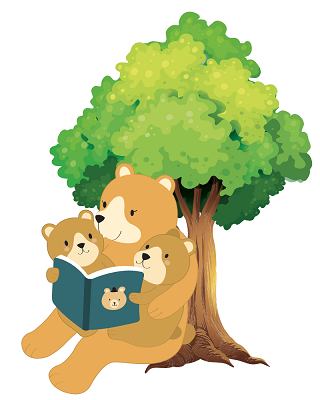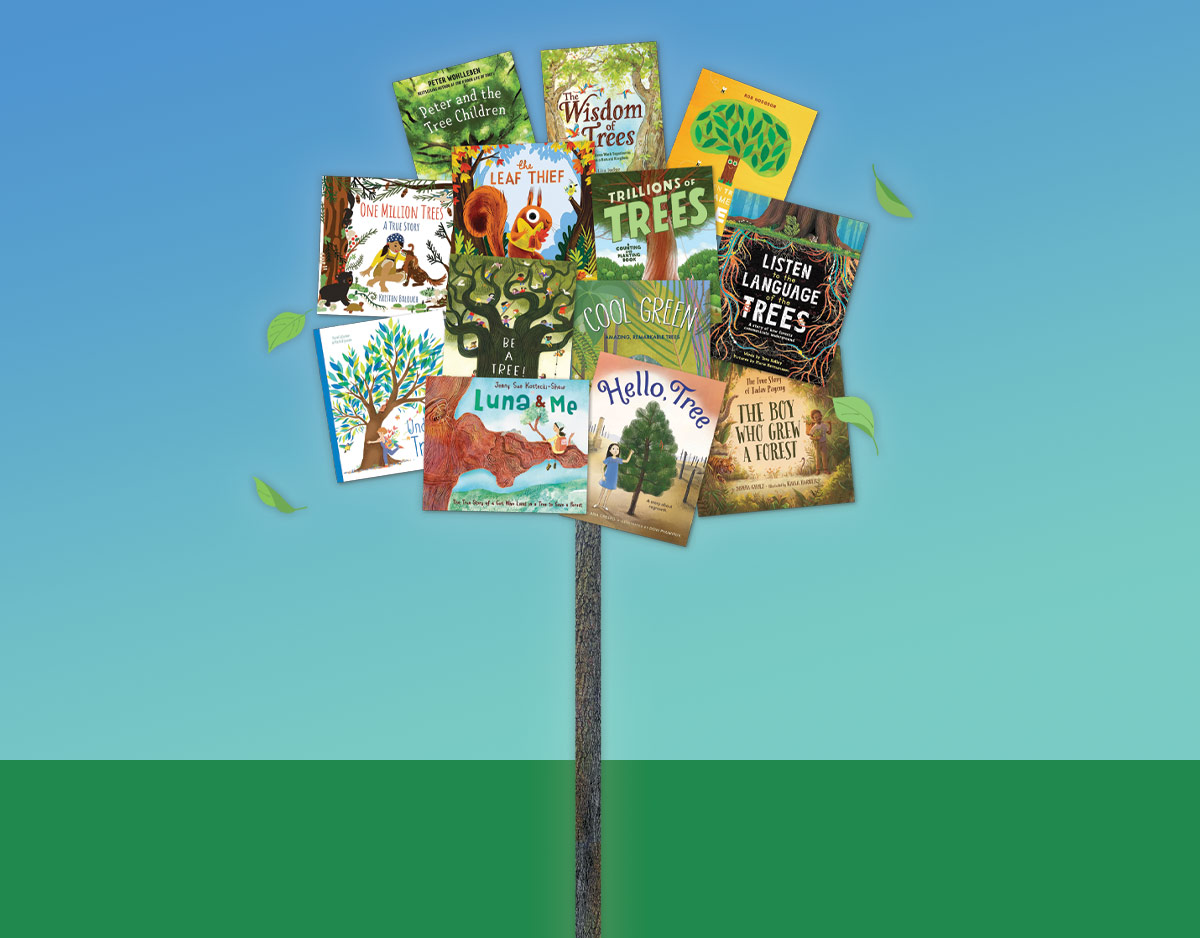2017 Geisel Winner: We Are Growing!

We Are Growing! (An Elephant & Piggie Like Reading! Book)
2017 Geisel Award Winner
Written by Laurie Keller; Illustrated by Laurie Keller
Published by Hyperion, 2016
ISBN 978-148472635-8
Book Review
Bam! Whee! Zap! Beep! Honk!
With each sound and exclamation, a different blade of grass grows. Amazed at each other’s sudden growth spurt, the anthropomorphic blades celebrate with enthusiasm. One declares itself the tallest, another the curliest, and so on until we reach Walt. Confused and uncertain, Walt doesn’t know what he is, and he doesn’t have much time to decide as a whirring lawnmower approaches from the background. But the lawnmower proves to be surprisingly helpful in Walt’s declaration. Introduced and framed by author/illustrator Mo Willems’ beloved duo Gerald the Elephant and Piggie, We Are Growing! is an amusing tale sure to engage young readers. Author/illustrator Laurie Keller’s text is also full of predictable patterns, speech bubbles, large font, sight words, and high-frequency words, making it a perfect text for emergent readers to tackle together or on their own. Similar to Willems’ style, Keller’s illustrations are packed with bold color, expressive faces, and sparse backgrounds. It’s no wonder Gerald and Piggie respond so positively at the book’s conclusion: We Are Growing! combines all the elements needed to make this book an engaging early reader.
Teaching Ideas and Invitations
- Ways to Grow. Gather a text set about how living things grow, and invite students to explore the different ways that growth happens. While some species grow up, others grow out. Trees grow up, out, and down (in roots). Physical growth is also not the only kind of growth that people experience. And most importantly, things—even within the same species—grow at different rates. You might also want to share Eric Carle’s How Things Grow or Katherine Ayres’ Up, Down, and Around as a follow-up text to read aloud after We Are Growing! See the list of books in the Further Explorations section below, as well as our entries on gardening books, for other titles.
- How Grass Grows. Use this book to introduce a unit about how grass grows. Following along with the book, help students plant different kinds of grass seeds to observe which grows the tallest, the neatest, the curliest, etc. You might want to set up a digital camera with time-lapse capabilities to record the growth of the grass while the class is away or busy doing other activities. You can also find several time-lapse videos of grass growing on YouTube. For fun, you can also have students make creative containers for their grass to grow in. Pinterest has lots of wonderful ideas, such as grass heads and grass hedgehogs, that you can make using everyday materials, such as cups, eggshells, baby food jars, or plastic bottles.
- We Are Growing! Using We Are Growing! as a mentor text, create a class or individual book that showcases how students have grown. Make sure that students study Keller’s text to include speech bubbles, expressive emotions, and other elements of the book that are effective for readers. Have them consider the different ways they have grown, from physically to academically to emotionally. It would be particularly great if you have taken photos of students all year long and could use those as part of the book making process to show how much they really have grown.
- Word Study: Forming Superlatives. The text of We Are Growing! provides some useful superlatives. Introduce the concept of superlatives to students, using examples from the book as well as others that students can come up with on their own. Challenge them to name some superlatives that don’t just add –est to the original word (e.g., bad, worse, worst; fun, more fun, most fun; good, better, best; little, less, least). Don’t forget to hold a discussion about the word “something-est” in the book. Is it grammatically correct? If not, why do they think the Laurie Keller used the word? Create a class anchor chart that reminds students of some of these superlative exceptions. You may also want to share Ruth Heller’s Many Luscious Lollipops: A Book about Adjectives, which has some information about creating superlatives from adjectives.
- Grass Puns. Point out the ways Laurie Keller and Mo Willems wrote their names on the back cover of the book to play with the idea of grass. Introduce students to the concept of puns and word play. After discussing the cleverness and humor behind the puns, have students try turning their own names into grass-related puns. Extend this playful challenge to other books they have read in class.
- Elephant and Piggie’s Recommended Book List. Although Mo Willems ended their book series ended earlier this year, best friends Gerald the Elephant and Piggie have “launched” their own series of Elephant and Piggie Like Reading books, in which the duo introduce and recommend other beginner reader books for children. Have students read the other books in the series that have been published and released thus far, Dan Santat’s The Cookie Fiasco and Charise Mericle Harper’s The Good for Nothing Button!, to determine what they have in common and why Elephant and Piggie approve of them. Have students read a wide variety of other beginner readers, using the criteria they identified to predict which of them Elephant and Piggie would also approve and recommend.
- Recommending Books and Book Talks. Using Elephant and Piggie’s front and back matter presentation of We Are Growing! as a model, have students identify other book characters they believe could be trusted sources for book recommendations. Have students create new end pages featuring these characters for a book they enjoyed. For example, the crayons in The Day the Crayons Quit might introduce a book about colors at the beginning and then give their opinions about the book at the end. Wrap these new end pages around the book, and display them in the classroom or school library. Alternatively, you could have students role-play the characters, having them make recommendations via book talks.
- Reader’s Theater. The dialogue-driven narrative and expressive language and faces make this book a good one for reader’s theater activities. Have your students practice reading the story aloud in small groups and then perform a reader’s theater version of it in different voices and with different intonation to hear all the ways it can be read aloud fluently.
- The Theodore S. Geisel Award. Discuss the fact that We Are Growing! has received an award that, in name, honors the work of Theodore Geisel, or Dr. Seuss. Compare We Are Growing! with one of Dr. Seuss’s beginning readers such as Hop on Pop. What is similar about the two books? What is different? What makes the books well suited for beginning readers? Expand this activity by gathering the other Geisel award winners and sharing the award criteria with your students. Distribute the books to small groups of students and ask them to discuss how in their view, the criteria apply to the winners. One important aspect of the books is that although the text is simple, the content is often sophisticated, requiring the reader works to construct more complex meaning through inference. As a further extension of this activity, you might ask older students to use what they have learned about books for beginning readers to author their own beginning reader book. These books can be shared with primary grade students. Further discussion of Geisel award winners and honors books can be found in our Classroom Bookshelf entry for Waiting, The Watermelon Seed, Up! Tall! and High!, Tales for Very Picky Eaters, I Want My Hat Back, and You Are (Not) Small. (This teaching idea originally appeared in our entry on Up! Tall! and High!)
- Author/Illustrator Study. Have students explore the work of either Laurie Keller or Mo Willems or both at literacy stations. You might want to group books by character or topic, so that each station has a specific theme (e.g., one station could be devoted to a particular series, another could be a station with animal characters, etc.). Have students circulate through each station, using graphic organizers to keep track of the similarities and differences between them. When the groups have gone through all of the stations, have them give presentations to one another sharing the similarities and differences they observed. These presentations can include charts and posters or they could be skits in which the characters from different books meet. (This teaching idea originally appeared in our entry on Little White Rabbit).
Critical Literacy
- Character Traits. Ask students what they think about identifying oneself or others as certain types of people. Are those traits permanent? How so? Could they change at any point? What are the benefits of identifying or labeling people with certain character traits? What are some possible consequences of that? How would they feel about being identified as a certain type of person, or about having to identify themselves as a certain type of person? After engaging in this discussion, invite students to list examples of book characters or real people who defied the traits and identities they were labeled with or initially believed themselves to be.
Further Explorations
Online Resources
Geisel Award Home Page
http://www.ala.org/alsc/awardsgrants/bookmedia/geiselaward
Geisel Award Criteria
Laurie Keller’s website
Mo Willems’ website
US National Arboretum – Grass Information for Kids
http://www.usna.usda.gov/Education/Kids.pdf
ScienceNetLinks – Look at Those Seeds Grow!
http://sciencenetlinks.com/lessons/look-at-those-seeds-grow/
Books
Ayres, K. (2008). Up, down, and around. Ill. by N. B. Wescott. Candlewick Press.
Brown, P. (2009). The curious garden. Little, Brown Books for Young Readers.
Carle, E. (2015). How things grow. Grosset & Dunlap.
Carle, E. (2009). The tiny seed. Little Simon.
Gibbons, G. (1991). From seed to plant. Holiday House.
Harris, T. E. (2011). Summer Jackson: Grown up. Ill. by A. G. Ford. Katherine Tegen Books.
Heller, R. (1998). Many luscious lollipops: A book about adjectives. Puffin Books.
Rockwell, A. (1999). One bean. Ill. by M. Halsey. Walker Childrens.
Torrey, R. (2009). Almost. HarperCollins.
Filed under: Awards, Beginner Readers
About Grace Enriquez
Grace is an associate professor of language and literacy at Lesley University. A former English Language Arts teacher, reading specialist, and literacy consultant, she teaches and writes about children’s literature, critical literacies, and literacies and embodiment. Grace is co-author of The Reading Turn-Around and co-editor of Literacies, Learning, and the Body.
ADVERTISEMENT
ADVERTISEMENT
SLJ Blog Network
One Star Review, Guess Who? (#211)
Free Piano (Not Haunted): A Cover Reveal and Q&A with Whitney Gardner
Kevin McCloskey on ‘Lefty’ | Review and Drawn Response
Notable NON-Newbery Winners: Waiting for Gold?
The Seven Bills That Will Safeguard the Future of School Librarianship
Take Five: Newbery Picks, Part Two
Gayle Forman Visits The Yarn!
ADVERTISEMENT





